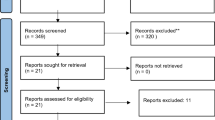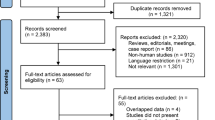Abstract
Background
Observational studies have suggested an increased risk of intracranial hemorrhage (ICH) associated with selective serotonin reuptake inhibitors (SSRIs) and other antidepressants primarily inhibiting serotonin reuptake.
Objectives
Our aim was to systematically review the available epidemiologic evidence regarding the risk of ICH associated with SSRIs and antidepressants inhibiting serotonin reuptake.
Methods
MEDLINE/PubMed and EMBASE were searched for all relevant articles in English, French, or German published before April 2017. Observational studies with SSRIs or any antidepressants classified by strength of serotonin reuptake inhibition as primary exposure, a comparison group, and ICH as outcome were eligible.
Results
Among twelve identified studies (six nested case-control, three cohort, two case-control, one case-crossover), seven assessed the risk of ICH associated with SSRIs (some also including other antidepressants primarily inhibiting serotonin reuptake), two the risk of ICH associated with inhibitors of serotonin reuptake according to the degree of reuptake inhibition, and three addressed both objectives. Four of ten studies showed an increased risk of ICH associated with SSRIs, with the two largest studies suggesting a moderate effect. Three of five studies showed an increased risk of ICH associated with strong inhibitors of serotonin reuptake. Limitations including residual confounding, inclusion of prevalent users, potentially inappropriate study designs, and lack of power may have influenced these results, especially in studies showing no association or a highly increased risk.
Conclusion
This systematic review suggests an increased risk of ICH with antidepressants primarily inhibiting serotonin reuptake, such as SSRIs. An increased risk of ICH with strong inhibitors of serotonin reuptake compared with weak inhibitors is also possible but the available evidence is limited. Antidepressants only moderately or weakly inhibiting serotonin reuptake might be preferred in high-risk patients.

Similar content being viewed by others
References
NICE. Depression in adults: recognition and management. 2016. https://www.nice.org.uk/guidance/cg902016.
Jiang HY, Chen HZ, Hu XJ, et al. Use of selective serotonin reuptake inhibitors and risk of upper gastrointestinal bleeding: a systematic review and meta-analysis. Clin Gastroenterol Hepatol. 2015;13(42–50):e3.
Hackam DG, Mrkobrada M. Selective serotonin reuptake inhibitors and brain hemorrhage: a meta-analysis. Neurology. 2012;79:1862–5.
Anglin R, Yuan Y, Moayyedi P, Tse F, Armstrong D, Leontiadis GI. Risk of upper gastrointestinal bleeding with selective serotonin reuptake inhibitors with or without concurrent nonsteroidal anti-inflammatory use: a systematic review and meta-analysis. Am J Gastroenterol. 2014;109:811–9.
Summary of Product Characteristics—Citalopram. 2017. https://www.medicines.org.uk/emc/medicine/238612017.
Bak S, Tsiropoulos I, Kjaersgaard JO, et al. Selective serotonin reuptake inhibitors and the risk of stroke: a population-based case-control study. Stroke. 2002;33:1465–73.
Shin D, Oh YH, Eom CS, Park SM. Use of selective serotonin reuptake inhibitors and risk of stroke: a systematic review and meta-analysis. J Neurol. 2014;261:686–95.
Halperin D, Reber G. Influence of antidepressants on hemostasis. Dialogues Clin Neurosci. 2007;9:47–59.
Tatsumi M, Groshan K, Blakely RD, Richelson E. Pharmacological profile of antidepressants and related compounds at human monoamine transporters. Eur J Pharmacol. 1997;340:249–58.
Sacco S, Marini C, Toni D, Olivieri L, Carolei A. Incidence and 10-year survival of intracerebral hemorrhage in a population-based registry. Stroke. 2009;40:394–9.
Broderick JP, Brott TG, Duldner JE, Tomsick T, Leach A. Initial and recurrent bleeding are the major causes of death following subarachnoid hemorrhage. Stroke. 1994;25:1342–7.
Mojtabai R. Increase in antidepressant medication in the US adult population between 1990 and 2003. Psychother Psychosom. 2008;77:83–92.
Castro VM, Gallagher PJ, Clements CC, et al. Incident user cohort study of risk for gastrointestinal bleed and stroke in individuals with major depressive disorder treated with antidepressants. BMJ Open. 2012;2:e000544.
Chen Y, Guo JJ, Patel NC. Hemorrhagic stroke associated with antidepressant use in patients with depression: does degree of serotonin reuptake inhibition matter? Pharmacoepidemiol Drug Saf. 2009;18:196–202.
Renoux C, Vahey S, Dell’Aniello S, Boivin JF. Association of selective serotonin reuptake inhibitors with the risk for spontaneous intracranial hemorrhage. JAMA Neurol. 2017;74:173–80.
Verdel BM, Souverein PC, Meenks SD, Heerdink ER, Leufkens HG, Egberts TC. Use of serotonergic drugs and the risk of bleeding. Clin Pharmacol Ther. 2011;89:89–96.
Wu CS, Wang SC, Cheng YC, Gau SS. Association of cerebrovascular events with antidepressant use: a case-crossover study. Am J Psychiatry. 2011;168:511–21.
Moher D, Liberati A, Tetzlaff J, Altman DG. Preferred reporting items for systematic reviews and meta-analyses: the PRISMA statement. PLoS Med. 2009;6:e1000097.
Liberati A, Altman DG, Tetzlaff J, et al. The PRISMA statement for reporting systematic reviews and meta-analyses of studies that evaluate health care interventions: explanation and elaboration. J Clin Epidemiol. 2009;62:e1–34.
Sterne J, Higgins J, Reeves B, On behalf of the development group for ACROBAT-NRSI. A Cochrane risk of bias assessment tool: for non-randomized studies of interventions (ACROBAT-NRSI), Version 1.0. 0, 24 September 2014. 2015.
Suissa S. Immortal time bias in observational studies of drug effects. Pharmacoepidemiol Drug Saf. 2007;16:241–9.
Suissa S, Dell’aniello S, Vahey S, Renoux C. Time-window bias in case-control studies: statins and lung cancer. Epidemiology (Cambridge, Mass). 2011;22:228–31.
Chen Y, Guo JJ, Li H, Wulsin L, Patel NC. Risk of cerebrovascular events associated with antidepressant use in patients with depression: a population-based, nested case-control study. Ann Pharmacother. 2008;42:177–84.
de Abajo FJ, Jick H, Derby L, Jick S, Schmitz S. Intracranial haemorrhage and use of selective serotonin reuptake inhibitors. Br J Clin Pharmacol. 2000;50:43–7.
Douglas I, Smeeth L, Irvine D. The use of antidepressants and the risk of haemorrhagic stroke: a nested case control study. Br J Clin Pharmacol. 2011;71:116–20.
Kharofa J, Sekar P, Haverbusch M, et al. Selective serotonin reuptake inhibitors and risk of hemorrhagic stroke. Stroke. 2007;38:3049–51.
Lee YC, Lin CH, Lin MS, Lu Y, Chang CH, Lin JW. Comparison of the effects of serotonin-norepinephrine reuptake inhibitors versus selective serotonin reuptake inhibitors on cerebrovascular events. J Clin Psychiatry. 2016;77:e1–7.
Smoller JW, Allison M, Cochrane BB, et al. Antidepressant use and risk of incident cardiovascular morbidity and mortality among postmenopausal women in the Women’s Health Initiative study. Arch Intern Med. 2009;169:2128–39.
Maclure M. The case-crossover design: a method for studying transient effects on the risk of acute events. Am J Epidemiol. 1991;133:144–53.
Lund JL, Richardson DB, Sturmer T. The active comparator, new user study design in pharmacoepidemiology: historical foundations and contemporary application. Curr Epidemiol Rep. 2015;2:221–8.
Daskalopoulou M, George J, Walters K, et al. Depression as a risk factor for the initial presentation of twelve cardiac, cerebrovascular, and peripheral arterial diseases: data linkage study of 1.9 million women and men. PLoS One. 2016;11:e0153838.
Hallas J, Pottegard A, Wang S, Schneeweiss S, Gagne JJ. Persistent user bias in case-crossover studies in pharmacoepidemiology. Am J Epidemiol. 2016;184:761–9.
Ray WA. Evaluating medication effects outside of clinical trials: new-user designs. Am J Epidemiol. 2003;158:915–20.
Schisterman EF, Cole SR, Platt RW. Overadjustment bias and unnecessary adjustment in epidemiologic studies. Epidemiology (Cambridge, Mass). 2009;20:488–95.
Caceres JA, Goldstein JN. Intracranial Hemorrhage. Emerg Med Clin N Am. 2012;30:771–94.
Swenson JR, Doucette S, Fergusson D. Adverse cardiovascular events in antidepressant trials involving high-risk patients: a systematic review of randomized trials. Can J Psychiatry Revue canadienne de psychiatrie. 2006;51:923–9.
Meretoja A, Strbian D, Putaala J, et al. SMASH-U: a proposal for etiologic classification of intracerebral hemorrhage. Stroke. 2012;43:2592–7.
NICE. Obsessive-compulsive disorder and body dysmorphic disorder: treatment. 2005. https://www.nice.org.uk/guidance/cg312005.
Acknowledgements
A.D. is a recipient of a Research Fellowship from the German Research Foundation (Deutsche Forschungsgemeinschaft, DFG).
Author information
Authors and Affiliations
Corresponding author
Ethics declarations
Funding
There was no funding for this study.
Conflict of interest
A.D., M.A., and C.R. do not have any conflicts of interest to disclose.
Electronic supplementary material
Below is the link to the electronic supplementary material.
Rights and permissions
About this article
Cite this article
Douros, A., Ades, M. & Renoux, C. Risk of Intracranial Hemorrhage Associated with the Use of Antidepressants Inhibiting Serotonin Reuptake: A Systematic Review. CNS Drugs 32, 321–334 (2018). https://doi.org/10.1007/s40263-018-0507-7
Published:
Issue Date:
DOI: https://doi.org/10.1007/s40263-018-0507-7




